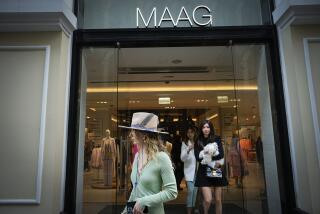Russian Women Are Warming Up to Fur
- Share via
MOSCOW — A lovely Russian woman tries on a sporty Italian mink jacket and smiles as she swirls in front of the mirror. Then she hangs up the fur and walks away.
Too costly? No, just not quite the right size.
“Three thousand [dollars] is not expensive--of course not,” says Irina Vronkevich, a 27-year-old former model who stopped working when she married a Russian businessman.
Vronkevich is among a growing number of Russian women who drape themselves in furs for the long winter. Some do worry about the cost, but almost no one worries about the animal rights issues that keep Western women in wool and goose down.
Russians’ love of furs, combined with the decline of domestic fur farms since the Soviet Union disintegrated in 1991, has opened up a huge new market for furriers in Europe and North America.
“It’s like the Gold Rush for the furriers,” said Edward Graf, president of New York’s exclusive Ben Kahn furs who was in Moscow for a recent fur exposition.
His grandfather, a native of Belarus, started the company. “He came to America for opportunity, like I came here,” said Graf. “Russia and China have a huge appetite for fur. For so long it was completely unavailable.”
During Soviet times, many Russians bundled up in fur hats and thick woolen coats with fur collars. While some managed a full coat of rabbit, nutria, Persian lamb or other cheap fur, few outside the Communist elite wore the long mink and sable coats popular among Russian women today.
Men, preferring sheepskin and leather coats, still cling to the classic fur hat.
And it’s not just Russia’s newly wealthy business people who are buying furs. Even though the average worker earns the equivalent of about $150 a month--more for those who work for private companies in Moscow--a surprising number of Russians seem able to come up with the money.
While demand climbs, production at Russia’s more than 200 fur farms is down 50% since 1990, said Viktor Chipurnoi, vice president of Soyuzpushina, a Russian fur trading company.
So to keep up with demand, Russia has been importing like mad. The Soviet Union had all but blocked out foreign fur, but that changed in the new market economy of post-Soviet Russia.
“We are not spoiled by things like the Green [anti-fur] movement,” said Chipurnoi. “It will not have an impact on Russia in the near future. What happens in five or 10 years, nobody knows.”
The international fur exhibition, which brought more than 100 firms to Moscow, drew crowds of shoppers and passed without the kinds of protest demonstrations it likely would have provoked in New York or London.
In the only sign of protest, three women--two English and one Russian--attempted to march onto Red Square wearing nothing but a banner that said they’d rather go naked than wear fur. They didn’t get far before police carted them away. They attracted no noticeable supporters.
When furs first became more available in Russia, people snapped up whatever they could get. Now, they increasingly are demanding coats in the latest designs made from the best pelts.
“You now need good quality coats,” said Roland Schuck, deputy director of Tukafurlux, a Dutch-Ukrainian joint venture. “Two or three years ago, it was easy to sell all the old junk here. Now, that’s finished.”
His company buys skins from many countries but shies away from Russian pelts.
“The animals have nothing to eat, just as the people in Russia have nothing to eat, so the quality of the skins goes down,” Schuck said.
Only American mink is used for the Russian-made coats hanging in the Laplandia shop not far from the Kremlin. The manager, Inna Stepanova, said she has no trouble selling the $15,000, one-of-a-kind coats.
Herman Jansen, president of North American Fur Auctions, said exports of Canadian and American skins to Russia are booming. Russians also are discovering North America’s wild furs, and 60% of raccoon skins and coats end up here, he added.
Scandinavia also sells pelts in quantity to Russia. Saga Furs, the marketer of all mink skins in Scandinavia, now sells 2 million pelts worth $76 million to Russia a year, said its spokesman, Tom Steifel Kristensen.
Still, for many Russians an imported fur coat remains out of reach.
“At $5,000 it’s impossible,” said Galina Petrova, who stopped at the fur exhibition to admire a Canadian sheared beaver coat. “I’ll try to buy a more democratic fur.”
More to Read
Sign up for Essential California
The most important California stories and recommendations in your inbox every morning.
You may occasionally receive promotional content from the Los Angeles Times.













